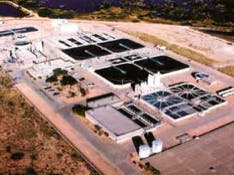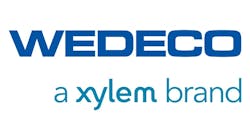The Rio Grande River and the two major aquifers in the El Paso, Texas, area had been dried up for decades when El Paso Water Utilities (EPWU) developed the Fred Hervey Water Reclamation Plant—the nation’s first full-scale wastewater reclamation plant to use tertiary treatment to restore wastewater to national and state potable water standards.
Scope
While the Hueco Bolson Aquifer’s users have a vital interest in reliable water supply, the issue of paramount importance for EPWU is how to provide an adequate supply of affordable drinking water for future generations. Recurring droughts only compound the challenge in this area, where the average rainfall is fewer than 9 in. per year.
Solution
Considered innovative from the outset, the award-winning Fred Hervey Water Reclamation Plant is a model for advanced water recycling facilities. The no-discharge plant is designed for continuous production, operating treatment trains consisting of screening, de-gritting, primary clarification, flow equalization, two-stage powdered activated carbon, two-stage re-carbonation, sand filtration, ozonation, granular activated carbon filtration and chlorination before entering storage and distribution.
The ozone system plays a critical role in the water reclamation treatment process by providing the first disinfection barrier in the treatment train. Ozone also helps to meet the utility’s goal of using fewer chemicals by reducing the amount of residual chlorine added.
When the original 450 lb/day ozone system needed to be replaced, EPWU selected Wedeco’s Effizon ozone generator, which is designed to produce 650 lbs/day. The dual units provide desired redundancy, as one high-performance Wedeco ozone generator can produce the plant’s maximum operational requirement. Ancillary equipment includes ozone injection systems (equipped with multiple nozzles), a nitrogen-boost system, two ozone destruct units and a central control panel. The generators operate using oxygen as the feed gas supply.
Once the wastewater has gone through each treatment step, EPWU returns the reclaimed water to the aquifer through three infiltration ponds. The reclaimed water trickles down a 200-ft layer of sand before reaching the aquifer, essentially mimicking the hydraulic recharge process as arroyos during and after a rainstorm.
Result
The Fred Hervey Water Reclamation plant is the cornerstone of EPWU’s water reclamation program. In 2009, the plant recycled more than 500 million gal of reclaimed water back into the aquifer at a cost of only $1.82 per thousand gal of water. This represented nearly one-fifth of the reclaimed water treated to potable quality at the EPWU facility.
The excellent quality standards include: effluent BOD: 1 mg/L; COD: 1 mg/L; TKN: less than 1 mg/L; NH: 0.2 mg/L; and THM: 0.05 ppm. For parameters such as chlorides and total dissolved solids, the plant can generally deliver 30% below the state permit limit. For other monitored constituents—such as sulfates, nitrates and turbidity—the plant generally operates at nearly 80% below the state permit limit.
Although the plant’s finished water doesn’t reach El Paso households directly, the recycled water continues to feed the Hueco Bolson Aquifer so it can one day be used by future generations as a water source. EPWU’s success at using innovative process technologies, such as ozone, for water reclamation continues to demonstrate a sustainable and effective method for water resource management.



